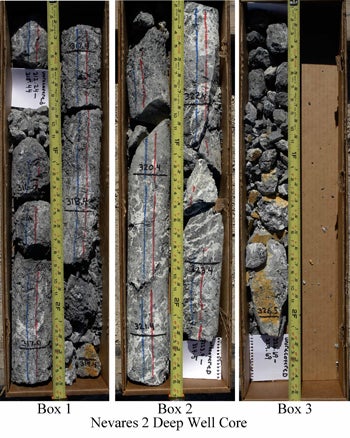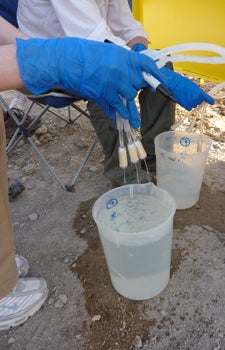Life Underground
USC Dornsife researchers have embarked on a five-year project to look for microorganisms hundreds of meters below the surface — in deep mineshafts, boreholes and other sites — as part of the search for the limits of life on Earth and the presence of life on other planets.
“Microorganisms are much more resilient than we used to think, and that has opened us up to thinking about life in the ‘subsurface biosphere’,” said Jan Amend, USC Dornsife professor of earth sciences and biological sciences. “If we’re not limited by sunlight, or if we’re not limited by the temperatures we see on surface, we can keep expanding our view of the biosphere on Earth and even on other planets.”
Amend, who is affiliated with the USC Wrigley Institute for Environmental Studies, housed in USC Dornsife, is leading a $6.7 million project to develop approaches for detecting and characterizing microbial life in the subsurface. The research is funded through the NASA Astrobiology Institute, an organization of competitively selected teams that conduct astrobiology research and training.
Amend is the principal investigator on a project called “Life Underground” and his colleagues include four other USC faculty members; a former USC faculty member who is now at Rensselaer Polytechnic Institute in Troy, New York; and three more researchers at the NASA Jet Propulsion Laboratory and the California Institute of Technology in Pasadena and at the Desert Research Institute in Las Vegas, Nevada.
Amend said the project will rely primarily on existing wells, boreholes and mineshafts (although it will drill some new holes, too), and the Jet Propulsion Laboratory will build life detection equipment that will be used at the sites a year or two from now. He said the studies in North American locations will be conducted in the context of the search for life on Mars and elsewhere in the solar system.
“Before we try this on Mars, let’s practice on Earth,” Amend said. “Let’s do ‘life detection’ and ‘life characterization’ in the terrestrial subsurface as a stepping stone toward doing this someday on Mars and other planets.”
And he said there are good reasons for focusing on life below the surface.
“If there is life on Mars, or if there ever was life on Mars — whether it is present or past life, extant or extinct—the chances of finding evidence of it on the surface are pretty slim. The chance of finding it in the subsurface is significantly higher.
The surface of Mars is incredibly violent, hostile and destructive to any kind of biosignature, whereas things get preserved much better when they are buried. If there’s life on Mars or if there’s evidence of past life, we have a much better chance of finding it in the subsurface.”

Rock core from Nevares Deep Well 2 in the Furnace Creek fault zone on the floor of Death Valley. This was the first site sampled by the “Life Underground” team and is of interest because the fault appears to have deeply-sourced groundwater. Photo by Richard Friese.
Amend’s research interests include microbial metabolism in extreme environments, microbial geochemistry in shallow-sea hydrothermal systems, and the origin and early evolution of life on Earth. He came to USC in August 2011 after more than a decade of work at Washington University in St. Louis, Mo., as an assistant and associate professor in the university’s Department of Earth and Planetary Sciences. He joined USC Dornsife as the associate director of the Center for Dark Energy Biosphere Investigations and also started his own microbial geochemistry lab, a project that involved an extensive remodeling of space in the Ahmanson Center on the University Park Campus and recruiting a lab manager, three graduate students and two post-docs to work there.
Along the way, he started talking about a proposal to the NASA Astrobiology Institute with Kenneth Nealson, Wrigley Chair in Environmental Studies and professor of earth sciences and biological sciences at USC Dornsife.
“We talked about what he was thinking and what I was thinking, and it made a lot of sense to put our two ideas together,” Amend said. “Our initial plan was to develop a ‘straw man’ idea—it wasn’t even a proposal yet—and then select a team of potential collaborators. We asked them all if they wanted to be co-investigators and they all happily agreed. I think the chances of our project getting funded were so low that it was easy for them all to say yes.”
The people who said “yes” to Amend and Nealson include Katrina Edwards, USC professor of earth sciences, biological sciences and environmental studies at USC Dornsife; Moh El-Naggar, assistant professor of physics at USC Dornsife, and Holly Willis, research assistant professor and director of academic programs at the USC Institute for Multimedia Literacy, part of the USC School of Cinematic Arts. Other co-investigators are Victoria Orphan, professor of geobiology at California Institute of Technology; Rohit Bhartia, a scientist at Jet Propulsion Laboratory; Duane Moser, a microbial and molecular ecologist at the Desert Research Institute in Las Vegas, and Yuri Gorby, professor of geomicrobiology at the Rensselaer Polytechnic Institute, formerly of USC Dornsife.
The group wrote a proposal called “Life Underground” and it was one of only five new projects to receive support from the NASA Astrobiology Institute out of 41 proposals that were submitted. Since the beginning of the year, the group has launched its first field campaign, sampling of the deep fluids of a well near Death Valley.
Laboratory experiments are underway to isolate and characterize novel subsurface microorganisms, and the lab work is being conducted by two USC Dornsife graduate students, Lily Momper and Yamini Jangir. Momper, a member of the Amend lab, is in the marine biology and biological oceanography Ph.D. program, and Jangir, a member of the El-Naggar lab, is in the physics Ph.D. program.

Testing water samples from a borehole for microorganisms using 0.2 micron filters. Photo by Duane Moser.
The “Life Underground” project builds on decades of research on extremophiles, organisms that survive and even thrive in extreme environments. They were discovered first in the hot springs of Yellowstone National Park and later in marine hydrothermal systems.
Amend said the study of extremophiles has expanded the discussion of where life can and cannot exist.
“Starting in the late 1970s, and through the 1980s and ’90s, the scientific community made a big push to search for life in extreme environments,” Amend said. “People started looking in high temperature systems, in acid environments, in high-pressure systems, in alkaline systems, in high radiation environments . . . People started going to these extremes of environmental conditions and, seemingly wherever they looked, they found microorganisms.”
Since 2010, the C-DEBI project at USC Dornsife is probing the rocks at the bottom of the ocean for “intraterrestrial” life, and now Amend’s team will lead the search for life deep beneath the surface of North America.
“We certainly expect to find life in the subsurface,” Amend said. “We also expect that as we go deeper, or as conditions become more extreme, we may hit ‘the limits of life.’ We might see life near the surface changing to different kinds of organisms in the subsurface and ultimately hitting a point below which there is no longer any life to be seen. Then we’d have to figure out what just happened over that interface.”